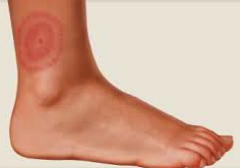ALERT ALERT ALERT : INCREASED LYME DISEASE REPORTED IN CALHOUN AND WV COUNTIES
Lyme Disease is on the rise WV, 200 cases in Mon County.
Lyme disease is a bacterial infection spread by deer ticks. The ticks are small, about the size of a poppy seed, so they are more difficult to spot than the common wood tick.
A 27-year-old Calhoun man who works on pipeline right-of-way cutting, contacted the disease and is a patient in Morgantown, having been made critically ill and requiring a pacemaker to be inserted.
Numerous other regional residents have the disease.
If a tick is found, carefully remove with a tweezer. It may be helpful to dab a little dish detergent on the tick which seems to make it release easier. A tick must be attached for 24 hours before Lyme disease can occur so checking for ticks can reduce the chances of contracting the disease.
 One of the early signs of Lyme disease is a âbullâs-eyeâ rash (shown left). This rash appears to look like a âbullâs-eyeâ with a red center and a red ring around the red center. This rash may be itchy and warm to the touch. If you develop this type of rash, seek medical attention.
One of the early signs of Lyme disease is a âbullâs-eyeâ rash (shown left). This rash appears to look like a âbullâs-eyeâ with a red center and a red ring around the red center. This rash may be itchy and warm to the touch. If you develop this type of rash, seek medical attention.
It is important to realize that not all will have a bullâs eye rash. Lyme disease is treated with antibiotics. Most patients have a full recovery. Symptoms usually appear from three to 30 days after being bitten. The Centers for Disease Control and Prevention (CDC) state that some people will continue to have symptoms after treatment.
Dogs are also prone to Lyme disease. Inspect your pet after they have spent time outdoors. If you find a tick on your pet, remove it immediately. Check furniture that your pet may frequent to make sure that a tick does not drop off them and attach to you later.
Some flea medications also protect animals from ticks as well. Horses and sometimes cattle can get Lyme disease. Symptoms usually present as lameness or stiffness, although most horses and cattle do not display any symptoms.